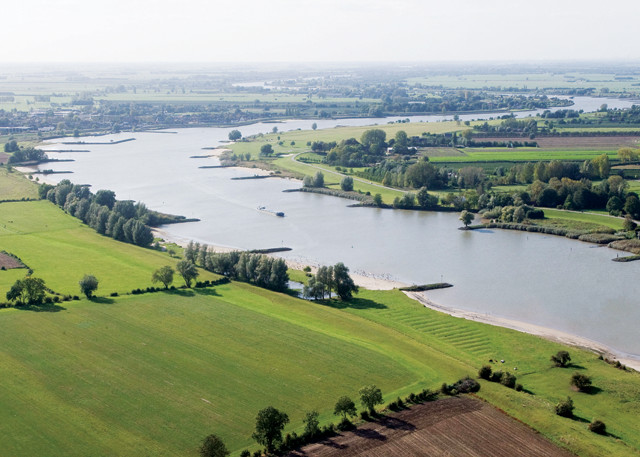
by Lucas Joel Thursday, January 17, 2019

The Lek River in the Netherlands formed as a result of avulsion triggered by human alteration of the surrounding landscape. Credit: Rijkswaterstaat/Joop van Houdt.
Meandering rivers that flow through and transport sediment to deltas often split off from their main courses and flow in different directions. This process, called avulsion, happens naturally when a river overflows its banks and the floodwaters carve out a new course for the river to follow. But humans can also trigger avulsions by changing the shape of the landscape, and in a new study, scientists report that people have been doing this for a very long time.
Farmers and settlers unintentionally caused two massive avulsions in the Rhine-Meuse Delta in the Netherlands nearly 2,000 years ago. The avulsions led to the formation of two new branches of the Rhine — the Hollandse IJssel and Lek — which diverted water south from the old course of the Rhine toward the Meuse. Today, these rivers flow through the Dutch provinces of Utrecht and South Holland before converging near Rotterdam.
Though the avulsions occurred in the early centuries A.D., the human alteration of the land that contributed began far earlier, in the last millennium B.C., according to the new study, published in Geology. Harm Jan Pierik, a geomorphologist at the University of Utrecht in the Netherlands, and his colleagues worked out the timing and sequence of events by dating sedimentary layers, mapping the location of different channels over time, and correlating those data with the ages of archaeological remains from human settlements.
There were two main human-induced effects that led to the avulsions, Pierik says. In the delta itself, in the area south of the old Rhine River, there is an estuary that was once a swamp filled with plants like trees and reeds. This scene changed, however, after humans began altering the landscape in about 250 B.C. by cutting back the vegetation to reclaim the land for agriculture. Over the ensuing centuries, people also built ditches and culverts that drained the soils of water, leading to about a meter of land subsidence. This helped prime the area for avulsion, because without vegetation and with a lowered landscape, “storm surges can come in more easily,” Pierik says. “The sea and the tides can propagate farther inland.”
The second human contribution to the avulsions was not in the delta itself, but upstream along the Rhine in Germany, where archaeological evidence revealed that settlers had been chopping down trees for centuries. Without tree roots gripping the soil, the landscape eroded more easily, increasing the sediment load in the Rhine, which, in the last millennium B.C., transported enough sediment to the Rhine-Meuse Delta to raise natural levees by about 1 meter. The increased sediment transport also caused downstream crevasse splays to grow faster and larger. These splays form where a river breaches its levees and floods a large area, leaving fan-shaped deposits and sometimes creating new river channels.
All of these changes, from deforestation upstream to land subsidence in the delta itself, combined to eventually trigger the avulsions that created the Hollandse IJssel by about A.D. 150 and the Lek by about 300, Pierik and his colleagues reported.
“This is the formation of new rivers — it’s an enormous thing,” says Jaap Nienhuis, a coastal geomorphologist at Florida State University who was not involved in the work. “What this article has done very nicely is show that, even 2,000 years ago, humans were able to inadvertently cause changes like this to deltas,” Nienhuis says.
“One of the most interesting implications is that human pressure, although occurring locally, can have big effects on a larger scale, and in this case the scale of the entire delta,” a lesson that’s relevant in modern water management, Pierik says. Today, he says, the need for local engineered solutions continues to grow in areas at risk of inundation from rising sea levels, like the Mississippi Delta. “If you want to protect a certain piece of a delta with something like a dike, you can do that,” he says. “But it’s very important for policymakers to be aware of how the entire system works.”
© 2008-2021. All rights reserved. Any copying, redistribution or retransmission of any of the contents of this service without the expressed written permission of the American Geosciences Institute is expressly prohibited. Click here for all copyright requests.